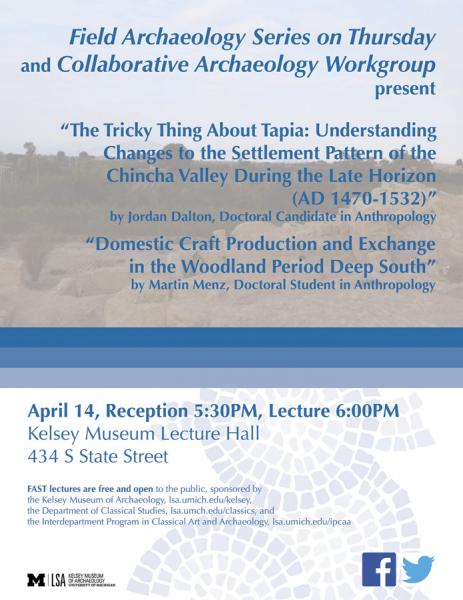FAST Lecture | Co-sponsored by CAW (The Collaborative Archaeology Workgroup)
Jordan Dalton, Martin Menz
Jordan Dalton, Doctoral Candidate in Anthropology:
The Tricky Thing About Tapia: Understanding Changes to the Settlement Pattern of the Chincha Valley During the Late Horizon (AD 1470-1532)
This talk will discuss possible changes made to the settlement pattern and urban centers of the Chincha Valley during the Late Horizon (AD1470-1532). The Late Horizon is defined by the presence of the expansionist Inca Empire in the Chincha Valley. From ethnohistoric sources and archaeological research we know that the Inca installed joint rule alongside the local Chincha elites. Under joint rule the Inca carefully developed and established their authority alongside that of the local Chincha. In order to understand the implications of this joint rule for the entire Chincha Valley I will look at settlement patterns for the lower valley and excavation data from the large urban agricultural center Las Huacas. The settlement pattern data for the Chincha Valley while rich, is restricted by the limited ability of researchers to differentiate between Late Intermediate Period (AD1100-1470) and Late Horizon occupations from the surface. This is a crucial distinction for understanding which changes in settlement pattern occurred during the Late Horizon under Inca occupation and which are the product of local socio-politcal development. I will conclude with a discussion of the organization of Chincha urbanism and highlight future lines of research for understanding how it may or may not have changed under joint rule.
Martin Menz, Doctoral Student in Anthropology:
Domestic Craft Production and Exchange in the Woodland Period Deep South
Archaeological considerations of craft production and specialization in the American Southeast have often focused on elaborate prestige goods crafted from exotic materials. Less frequently studied is the potential for specialized production of mundane household goods. Here I review the evidence for craft production and exchange from Kolomoki, a large Middle-to-Late Woodland period (A.D. 300-850) village and mound complex in southwestern Georgia, and attempt to situate it within a series of exchange networks predicated upon periodic ritual gatherings and regional interaction. I argue that periodic convergence at Kolomoki and other mound centers temporarily brought together individuals from various ecological and geological zones, providing an outlet for craft producers and visitors to exchange raw materials and finished goods.
Reception 5:30 PM, Lecture 6:00 PM.
FAST lectures are free and open to the public.
The Tricky Thing About Tapia: Understanding Changes to the Settlement Pattern of the Chincha Valley During the Late Horizon (AD 1470-1532)
This talk will discuss possible changes made to the settlement pattern and urban centers of the Chincha Valley during the Late Horizon (AD1470-1532). The Late Horizon is defined by the presence of the expansionist Inca Empire in the Chincha Valley. From ethnohistoric sources and archaeological research we know that the Inca installed joint rule alongside the local Chincha elites. Under joint rule the Inca carefully developed and established their authority alongside that of the local Chincha. In order to understand the implications of this joint rule for the entire Chincha Valley I will look at settlement patterns for the lower valley and excavation data from the large urban agricultural center Las Huacas. The settlement pattern data for the Chincha Valley while rich, is restricted by the limited ability of researchers to differentiate between Late Intermediate Period (AD1100-1470) and Late Horizon occupations from the surface. This is a crucial distinction for understanding which changes in settlement pattern occurred during the Late Horizon under Inca occupation and which are the product of local socio-politcal development. I will conclude with a discussion of the organization of Chincha urbanism and highlight future lines of research for understanding how it may or may not have changed under joint rule.
Martin Menz, Doctoral Student in Anthropology:
Domestic Craft Production and Exchange in the Woodland Period Deep South
Archaeological considerations of craft production and specialization in the American Southeast have often focused on elaborate prestige goods crafted from exotic materials. Less frequently studied is the potential for specialized production of mundane household goods. Here I review the evidence for craft production and exchange from Kolomoki, a large Middle-to-Late Woodland period (A.D. 300-850) village and mound complex in southwestern Georgia, and attempt to situate it within a series of exchange networks predicated upon periodic ritual gatherings and regional interaction. I argue that periodic convergence at Kolomoki and other mound centers temporarily brought together individuals from various ecological and geological zones, providing an outlet for craft producers and visitors to exchange raw materials and finished goods.
Reception 5:30 PM, Lecture 6:00 PM.
FAST lectures are free and open to the public.
| Building: | Kelsey Museum of Archaeology |
|---|---|
| Event Type: | Lecture / Discussion |
| Tags: | Anthropology, Archaeology, Lecture |
| Source: | Happening @ Michigan from Kelsey Museum of Archaeology, Collaborative Archaeology Workgroup, Interdepartmental Program in Ancient Mediterranean Art and Archaeology, Kelsey Museum of Archaeology Lectures |


